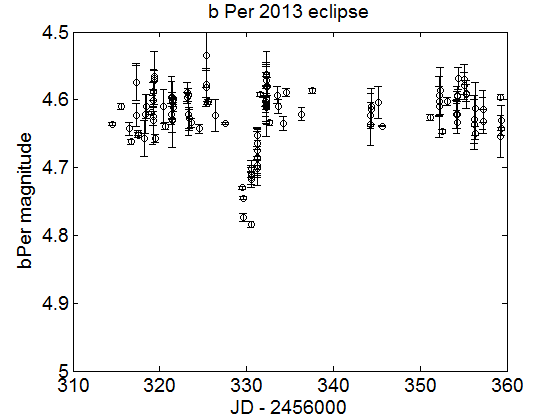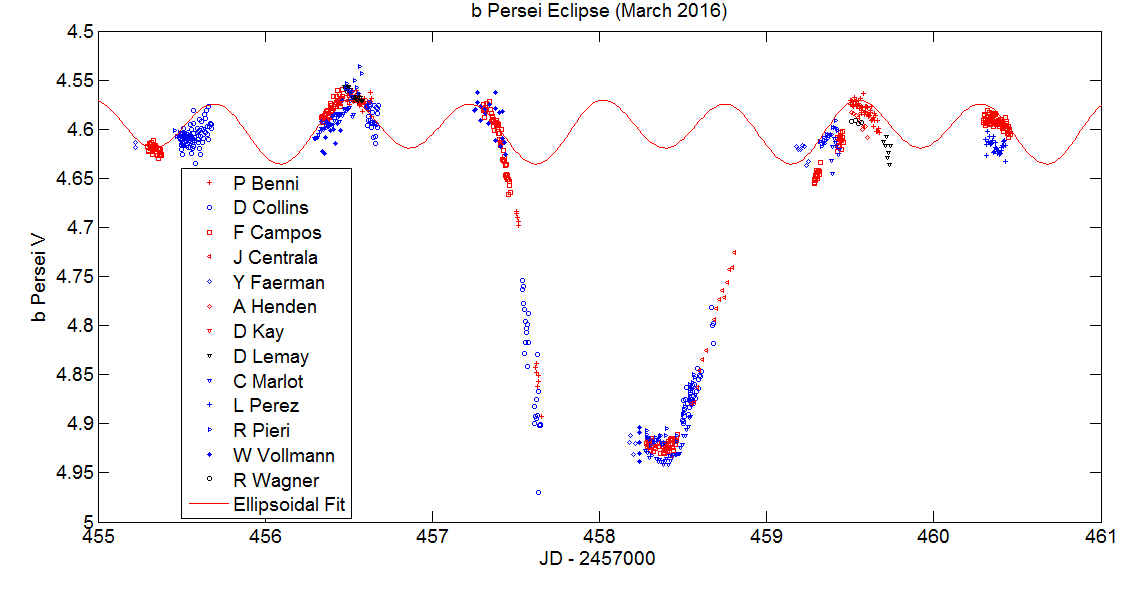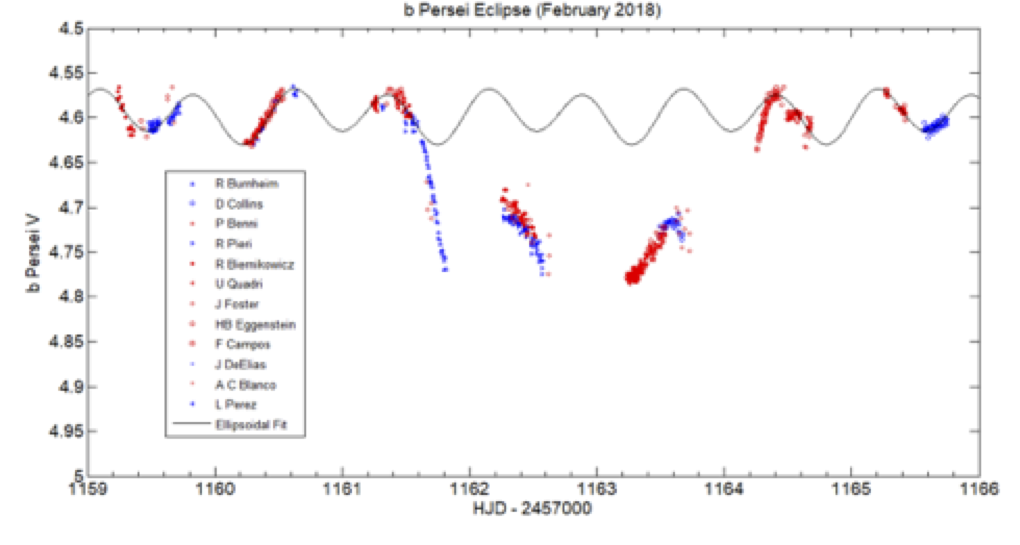Note: Text revised October 30 to include date and time on which the predicted eclipse window is centered. It was further revised November 2 to correct the SAO number of b Per and to correct the position of the check star. - E. O. Waagen
October 30, 2018: The bright multiple, eclipsing system b Per has been the subject of several AAVSO campaigns (AAVSO Alert Notices 476 (20130104), 507 (20150107), 537 (20160226), 563 (20161202), and 610 (20180126)). A new AAVSO campaign on b Per has been launched at the request of Dr. Donald F. Collins, who writes:
"Dr. Donald F. Collins (AAVSO member), Dr. Robert Zavala (US Naval Observatory, Flagstaff Station), Jason Sanborn (Lowell Observatory), and Dr. Anatoly Miroshnichenko (University N. Carolina, Greensboro) have requested high time-resolution observations of the bright star b Persei (magnitude 4.6) during the next predicted eclipse, or transit, of the third star across the system. The third star is predicted to transit behind the inner pair of the triple system during the week centered on November 21, 2018 [centered on JD: 2458443.95 = 10:48 UT Nov. 21, 2018]. This will be the fifth transit (including primary and secondary eclipses) observed by the AAVSO observers since the AAVSO detected the first recorded eclipse in February, 2013 (Figure 1). AAVSO observers have recorded excellent time-series observations of the light curves for the last 4 transits. The light curves of each of the previous observed eclipses are shown in Figures 1 – 5.
"The b Persei system (HIP 20070, SAO 24531, HR 1324, HD 26961) consists of three stars. The A and B components are close-orbiting (1.5237 d period) in a low-inclined orbit that exhibits ellipsoidal variation (~0.06 magnitude variation) with no eclipses. The brightest star of the pair is spectral class A2V. The other two stars in the system are believed to be spectral class F (G. Hill et al., 1976, ApJ, 208,152). The previous high time-resolved transits by the AAVSO observers have revealed the following results: 1) Both the primary and secondary transits show significant light curve dips in total brightness on the order of 0.15 mag to 0.3 mag. 2) The orbital period for the C star is 704.9 d based on the time difference between successive transits of the same primary/secondary phase of the C orbit. The previously published orbital period is 702 d (Hill, 1976). 3) Modern radial velocity observations by Anatoly Miroshnichenko, which separate the short period RV oscillations from the long period RV oscillation, have indicated that the eclipses observed in Feb. 2013, Jan. 2015, Dec. 2016, (Figures 1, 2, 4) and the upcoming Nov. 2018 eclipse are all secondary eclipses, where the C star transits behind the A-B pair. The spectra so far have yielded only the spectra of star A of the system – believed to be the brightest member of the system. The transits observed in Mar. 2016 and Feb. 2018 (Figures 3 and 5) are both primary eclipses where the C star temporarily blocks some of the light from the close-orbiting A-B pair.
"Observers are asked to obtain high-resolution time-series observations of long durations in V (or the green channel from DSLR) during the eclipses as well as time-series observations of the system out of eclipse for the two weeks surrounding the expected November 21, 2018 date (Nov. 14 to Nov. 28, 2018). Out of eclipse data are important to calibrate the various offsets expected from different observing systems. It is recommended to use the star HIP 20156 = SAO 39457 = HR 1330 = HD 27084 (the star labeled '55') in the AAVSO finder chart at 5.456 V as the comparison star. For a check star HIP 20370 (J2000 RA, dec = 04 21 45.47 +50 02 06.64) may be used if the observer's field of view is about one degree. This star is not in the AAVSO sequence. Any other AAVSO sequence stars may be used as check stars if available in the observer's field of view. New observers are welcome - especially Asian and Pacific observers to help fill the gaps in the transit light curves. Simulation of the light curves are being developed. More transit observations are needed to narrow the physical parameters of the A, B, and C stars to help determine the physical nature of the three stars.
"CCD and DSLR observers should follow some simple guidelines to observe bright stars: Integration times should be kept longer than about 15 seconds by stopping down the aperture of the optics if necessary to prevent saturation. Otherwise atmospheric scintillations during short exposures add significantly to the noise. With short focal-length telescopes or lenses – needed for large fields of view for bright stars and the sequences – de-focusing (FWHM ~ 4 pixels) is also preferred to avoid under-sampling among pixels on the detector array. Co-adding the photometry data (between 5 and 20 observations averaged) or stacking the same number of images will reduce the point-to-point noise even further. It is also important to obtain out-of-eclipse observations both before and after the event in order to match the varying zero point offsets from different observers and to match the out-of-eclipse light curves with the ellipsoidal light curve of b Persei. Keep the same observing protocol for all observations. Observers should also concentrate on obtaining time-series of long duration each night – especially in mid-eclipse as the transit time duration between any two stars is about six hours. It is also hoped to receive observations from western N. America, Pacific Islands, and Asian observers in addition to the strong coverage from Europe and eastern N. America. [For an excellent DSLR discussion], see Buchheim (2018, “Lessons from DSLR Photometry of b Per “Third Star” Eclipse (February 2018)”, SAS-2018 The Symposium on Telescope Science and ALPO Annual 2018 Meeting, Proceedings for the 37th Annual Conference of the Society for Astronomical Sciences. [http://www.socastrosci.org/Publications.html]).
"Please submit all photometry data to the AAVSO International Database via WebObs at the AAVSO site, using the name B PER. A thread on the AAVSO Campaign and Observation Reports forum [https://www.aavso.org/november-2018-b-per-campaign] will be maintained to advise observers of latest developments: eclipse onsets, observing ideas.
"Spectroscopy will also be extremely valuable, especially when the C star is expected to pass behind the A and B stars at different times throughout the eclipse during the three days centered on Nov. 21, 09:30 UT. We hope to see small changes in some parts of the spectra if the C star is totally or partially eclipsed. Please send any spectroscopy observations to Dr. Anatoly Miroshnichenko <a_mirosh@uncg.edu> . All spectroscopy data should be displayed with the following guidelines:
"The FITS header should include: coordinates of the observing place; the observer name, RA & DEC of the star, UT time of the observation (better mid-point), exposure time in seconds. The intensities need to be in ADU (not normalized to the continuum) and wavelength scale needs to be geocentric.
"If the standard cannot be met, Dr. Miroshnichenko would need specific explanations of the data taking circumstances."

Figure 1: The first transit observations of b Persei by AAVSO. February 2013. These are a series of "snapshots".

Figure 2: The first high time-resolution transit of b Persei by AAVSO. January 2015. (Transit 1)

Figure 3: The first primary eclipse of b Persei by star C. AAVSO March 2016. (Transit 2)

Figure 4: The December 2016 transit by AAVSO observers showing the second high time-resolution secondary eclipse. (Transit 3)

Figure 5: The February 2018 primary eclipse of b Persei by AAVSO observers. (Transit 4)
Coordinates (2000.0): R.A. 04 18 14.62 Dec. +50 17 43.8 (J2000)
Finder charts with a comparison star sequence for b Per may be created using the AAVSO Variable Star Plotter (VSP).
As requested above, please submit photometry observations to the AAVSO International Database using the name B PER. Please submit spectroscopy observations to Dr. Anatoly Miroshnichenko <a_mirosh@uncg.edu> following the requirements above.
This AAVSO Alert Notice was compiled by Elizabeth O. Waagen using material supplied by Dr. Collins.
----------------------------------
SUBMIT OBSERVATIONS TO THE AAVSO
Information on submitting observations to the AAVSO may be found at:
https://www.aavso.org/webobs
ALERT NOTICE ARCHIVE AND SUBSCRIPTION INFORMATION
An Alert Notice archive is available at the following URL:
https://www.aavso.org/aavso-alert-notices-for-observing-campaigns-and-discoveries
Subscribing and Unsubscribing may be done at the following URL:
https://www.aavso.org/aavso-alert-notice-subscribe
-------------------------------------------------
Please support the AAVSO and its mission -- Join or donate today:
https://www.aavso.org/apps/donate/

